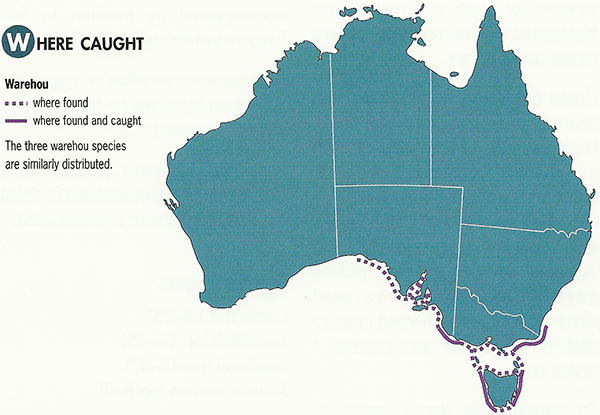Blue warehou have a thick fillet with very few bones.
Warehous are ideal for smoking, grilling, frying, baking or barbecuing. Being slightly dry, they also marinate wonderfully in citrus or rice wine flavours.
Catch limits
| Catch limit | Fishing Mortality* | Biomass** |
|---|---|---|
Catch Limit (Incidental) 30 tonnes For the 2025–26 Season | Y;Uncertain | R;Overfished |
* Fishing mortality status relates to the level of fishing pressure on a stock - specifically, whether fishing mortality in the year being assessed is likely to result in the stock becoming overfished, or prevent the stock from rebuilding from an overfished state. If fishing mortality exceeds either of these thresholds, a stock is considered to be subject to overfishing.
** Biomass status relates to how many fish there are - specifically, whether the biomass in the year being assessed is above the level at which the risk to the stock is considered to be unacceptable. The HSP defines this level as the limit reference point, below which the stock is considered to be overfished.
Scientific name: Seriolella brama
Family: Centrolophidae
Other names: Snotty trevally, snotty trevalla, sea bream, haddock, Portland hake, snotty, warehou, Tasmanian trevally, snotgall, black trevally
Description: Blue warehou are dark bluish green above, somewhat iridescent, with a silvery white belly. They have a small head, plump body, and a blackish spot by the pectoral fin.
Size (length and weight): Up to 76 cm in length and 4 kg. Commonly found at about 50 cm in length.
Life span: Up to 15 years.
Habitat: Blue warehou are a bentho-pelagic species that inhabits continental shelf and slope waters. Adults can be found at depths from 50‑300 metres. Blue warehou are a schooling fish and usually aggregate close to the sea bed. Juveniles can sometimes be found schooling close to the surface in estuaries, often in association with jellyfish.
Prey: Salps and pyrosomes (planktonic tunicates), krill, crabs and small squid.
Predators: Key predators are unknown, although there are records of blue warehou in the stomach contents of school sharks.
Reproduction: Blue warehou reach reproductive maturity at about 3 years of age. Spawning occurs during winter and early spring. The primary spawning ground is off western Victoria and Tasmania. On average females spawn around three times per season. Females produce 430 000‑1 350 000 eggs per spawning event depending on their body size.
Other notes: Blue warehou are listed as Conservation Dependent under the EPBC Act and are managed under AFMA’s Blue Warehou Stock Rebuilding Strategy.
| Fishery | Gear | Catch of this species is targeted or incidental |
|---|---|---|
| Southern and Eastern Scalefish and Shark Fishery – Gillnet, Hook and Trap Sector | Gillnet | Incidental |
| Southern and Eastern Scalefish and Shark Fishery – Great Australian Bight Trawl Sector | Bottom trawl | Incidental |
| Southern and Eastern Scalefish and Shark Fishery – Commonwealth Trawl Sector | Bottom and midwater trawl | Incidental |
| Recreational | Rod and line and gillnet | Targeted, mainly in Tasmania. |
The Commonwealth catch of blue warehou around Australia is managed by quota. This means the catch of this fish by commercial fishers is restricted by weight.
AFMA also restricts the type and amount of gear that can be used to fish for blue warehou.
Commercial fishermen are required to fill in records of their catches, during each fishing trip and when they land their catch in a port. This helps us keep records of how much is being caught.
AFMA decide on the amount that can be caught each year from expert advice and recommendations from fisheries managers, industry members, scientist and researchers.
Commercial fishermen are not allowed to target blue warehou.
Blue warehou has an approved rebuilding strategy.
Scientist consider that there is good evidence that there are two stocks of blue warehou found in Australian waters, an eastern stock and a western stock. These stocks are separated by a boundary in the Bass Strait.
Blue warehou are caught primarily on or near the bottom.

The main fishing method that incidentally catches blue warehou is bottom trawling.
Sometimes, bottom trawling can catch unwanted species of fish (not the type of fish the net was supposed to catch). This is known as bycatch and it is monitored by on-board fishery observers who assess the environmental impact of the trawling.
Although it is not physically possible to trawl on reef structures, significant long-term damage can occur if sensitive habitat areas like corals, sponges and seagrass beds are trawled. To ensure these sensitive habitat areas are protected from trawling, management arrangements such as area closures are extensively used.
AFMA carries out ecological risk assessments for all of its major fisheries. The impact of bottom trawl on bycatch species and habitats has been assessed as part of the risk assessment. AFMA mitigates, or reduces, that impact through its ecological risk management strategy. The strategy details a number of management arrangements and strategies which aim to reduce the impact of fishing on the environment, including:
- minimum mesh sizes for bottom trawls to reduce the catch of small and juvenile fish
- mitigation devices to reduce interactions with threatened, endangered and protected species
- and closing areas to fishing to protect vulnerable species and habitats.
All bottom trawl boats are required to have a seabird management plan in place to reduce interactions with seabirds during fishing.
Gear
Want to know more?
This is just an overview of blue warehou, if you want to know more see the links below.
This fish is managed under the Southern and Eastern Scalefish and Shark Fishery.